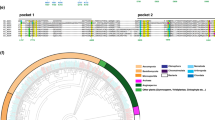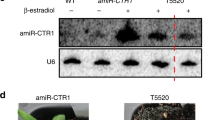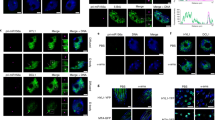Abstract
MicroRNAs (miRNAs) are 21–24-nucleotide RNAs present in many eukaryotes that regulate gene expression as part of the RNA-induced silencing complex. The sequence identity of the miRNA provides the specificity to guide the silencing effector Argonaute (AGO) protein to target mRNAs via a base-pairing process1. The AGO complex promotes translation repression and/or accelerated decay of this target mRNA2. There is overwhelming evidence both in vivo and in vitro that translation repression plays a major role3,4,5,6,7. However, there has been controversy about which of these three mechanisms is more significant in vivo, especially when effects of miRNA on endogenous genes cannot be faithfully represented by reporter systems in which, at least in metazoans, the observed repression vastly exceeds that typically observed for endogenous mRNAs8,9. Here, we provide a comprehensive global analysis of the evolutionarily distant unicellular green alga Chlamydomonas reinhardtii to quantify the effects of miRNA on protein synthesis and RNA abundance. We show that, similar to metazoan steady-state systems, endogenous miRNAs in Chlamydomonas can regulate gene expression both by destabilization of the mRNA and by translational repression. However, unlike metazoan miRNA where target site utilization localizes mainly to 3′ UTRs, in Chlamydomonas utilized target sites lie predominantly within coding regions. These results demonstrate the evolutionarily conserved mode of action for miRNAs, but details of the mechanism diverge between the plant and metazoan kingdoms.
This is a preview of subscription content, access via your institution
Access options
Access Nature and 54 other Nature Portfolio journals
Get Nature+, our best-value online-access subscription
$29.99 / 30 days
cancel any time
Subscribe to this journal
Receive 12 digital issues and online access to articles
$119.00 per year
only $9.92 per issue
Buy this article
- Purchase on Springer Link
- Instant access to full article PDF
Prices may be subject to local taxes which are calculated during checkout




Similar content being viewed by others
References
Bartel, D. P. MicroRNAs: target recognition and regulatory functions.Cell 136, 215–233 (2009).
Ameres, S. L. & Zamore, P. D. Diversifying microRNA sequence and function. Nat. Rev. Mol. Cell Biol. 14, 475–488 (2013).
Jonas, S. & Izaurralde, E. Towards a molecular understanding of microRNA-mediated gene silencing. Nat. Rev. Genet. 16, 421–433 (2015).
Filipowicz, W., Bhattacharyya, S. N. & Sonenberg, N. Mechanisms of post-transcriptional regulation by microRNAs: are the answers in sight? Nat. Rev. Genet. 9, 102–114 (2008).
Iwakawa, H. O. & Tomari, Y. The functions of microRNAs: mRNA decay and translational repression. Trends Cell Biol. 25, 651–665 (2015).
Bazzini, A. A., Lee, M. T. & Giraldez, A. J. Ribosome profiling shows that miR-430 reduces translation before causing mRNA decay in zebrafish. 336, 233–237 (2012).
Izaurralde, B. E. Breakers and blockers— miRNAs at work. Science 349, 380–382 (2015).
Eichhorn, S. W. et al. mRNA destabilization is the dominant effect of mammalian microRNAs by the time substantial repression ensues. Mol. Cell 56, 104–115 (2014).
Guo, H., Ingolia, N. T., Weissman, J. S. & Bartel, D. P. Mammalian microRNAs predominantly act to decrease target mRNA levels. Nature 466, 835–840 (2010).
Bazzini, A. A., Lee, M. T. & Giraldez, A. J. Ribosome profiling shows that miR-430 reduces translation before causing mRNA decay in zebrafish. Science 336, 233–237 (2012).
Béthune, J., Artus-Revel, C. G. & Filipowicz, W. Kinetic analysis reveals successive steps leading to miRNA-mediated silencing in mammalian cells. EMBO Rep. 13, 716–723 (2012).
Djuranovic, S., Nahvi, A. & Green, R. miRNA-mediated gene silencing by translational repression followed by mRNA deadenylation and decay. Science 336, 237–240 (2012).
Brodersen, P. & Voinnet, O. Target recognition and mode of action. Nat. Rev. Mol. Cell Biol. 10, 141–148 (2009).
Reis, R. S., Hart-Smith, G., Eamens, A. L., Wilkins, M. R. & Waterhouse, P. M. Gene regulation by translational inhibition is determined by Dicer partnering proteins. Nat. Plants 1, 1–6 (2015).
Li, S. et al. MicroRNAs inhibit the translation of target mRNAs on the endoplasmic reticulum in Arabidopsis. Cell 153, 562–574 (2013).
Brodersen, P. et al. Widespread translational inhibition by plant miRNAs and siRNAs. Science 320, 1185–1190 (2008).
Iwakawa, H. & Tomari, Y. Molecular insights into microRNA-mediated translational repression in plants. Mol. Cell 52, 591–601 (2013).
Baek, D. et al. The impact of microRNAs on protein output. Nature 455, 64–71 (2008).
Hendrickson, D. G. et al. Concordant regulation of translation and mRNA abundance for hundreds of targets of a human microRNA. PLoS Biol. 7, 25–29 (2009).
Molnar, A., Schwach, F., Studholme, D. J., Thuenemann, E. C. & Baulcombe, D. C. miRNAs control gene expression in the single-cell alga Chlamydomonas reinhardtii. Nature 447, 1126–1129 (2007).
Valli, A. A. et al. Most microRNAs in the single-cell alga Chlamydomonas reinhardtii are produced by Dicer-like 3-mediated cleavage of introns and untranslated regions of coding RNAs. Genome Res. 26, 519–529 (2016).
Yamasaki, T. et al. Complementarity to an miRNA seed region is sufficient to induce moderate repression of a target transcript in the unicellular green alga Chlamydomonas reinhardtii. Plant J. 76, 1045–1056 (2013).
Yamasaki, T., Kim, E.-J., Cerutti, H. & Ohama, T. Argonaute3 is a key player in miRNA-mediated target cleavage and translational repression in Chlamydomonas. Plant J. 85, 258–268 (2016).
Chung, B. Y. et al. The use of duplex-specific nuclease in ribosome profiling and a user-friendly software package for Ribo-seq data analysis. RNA 21, 1731–1745 (2015).
Lewis, B. P., Shih, I., Jones-Rhoades, M. W., Bartel, D. P. & Burge, C. B. Prediction of mammalian microRNA targets. Cell 115, 787–798 (2003).
Agarwal, V., Bell, G. W., Nam, J. W. & Bartel, D. P. Predicting effective microRNA target sites in mammalian mRNAs. Elife 4, (2015).
Schirle, N. T., Sheu-Gruttadauria, J. & MacRae, I. J. Structural basis for microRNA targeting. Science 346, 608–613 (2014).
Mallory, A. C. et al. MicroRNA control of PHABULOSA in leaf development: importance of pairing to the microRNA 5′ region. EMBO J. 23, 3356–64 (2004).
Gao, X. et al. MicroRNAs modulate adaption to multiple abiotic stresses in Chlamydomonas reinhardtii. Sci. Rep. 6, 38228 (2016).
Korostelev, A., Trakhanov, S., Laurberg, M. & Noller, H. F. Crystal structure of a 70S ribosome–tRNA complex reveals functional interactions and rearrangements. Cell 126, 1065–1077 (2006).
Qu, X. et al. The ribosome uses two active mechanisms to unwind messenger RNA during translation. Nature 475, 118–121 (2011).
Gerashchenko, M. V. & Gladyshev, V. N. Translation inhibitors cause abnormalities in ribosome profiling experiments. Nucleic Acids Res. 42, e134 (2014).
Gutteridge, A. et al. Nutrient control of eukaryote cell growth: a systems biology study in yeast. BMC Biol. 8, 68 (2010).
Marondedze, C. et al. A quantitative phosphoproteome analysis of cGMP-dependent cellular responses in Arabidopsis thaliana. Mol. Plant 9, 621–623 (2016).
Brosch, M., Yu, L., Hubbard, T. & Choudhary, J. Accurate and sensitive peptide identification with mascot percolator. J. Proteome Res. 8, 3176–3181 (2009).
Ingolia, N. T., Ghaemmaghami, S., Newman, J. R. S. & Weissman, J. S. Genome-wide analysis in vivo of translation with nucleotide resolution using ribosome profiling. Science 324, 218–223 (2009).
Hardcastle, T. J. & Kelly, K. A. baySeq: empirical Bayesian methods for identifying differential expression in sequence count data. BMC Bioinform. 11, 422 (2010).
Bonnet, E., He, Y., Billiau, K. & van de Peer, Y. TAPIR, a web server for the prediction of plant microRNA targets, including target mimics. Bioinformatics 26, 1566–1568 (2010).
Acknowledgements
We thank J. Barlow for technical assistance and medium preparation; T.J. Hardcastle and B. Santos for technical bioinformatic support; A. Valli for providing the silencing mutants, and A. Molnar and A.E. Firth for discussions. This work was supported by a Balzan Prize award and the European Research Council Advanced Investigator Grant ERC-2013-AdG 340642 TRIBE (D.C.B). B.Y.-W.C. was supported by an EMBO long-term postdoctoral fellowship and a Sir Henry Wellcome Fellowship [096082]. D.C.B. is the Royal Society Edward Penley Abraham Research Professor.
Author information
Authors and Affiliations
Contributions
B.Y.-W.C. and D.C.B. conceived and designed the research. B.Y.-W.C performed the experiments and analysed the data. M.J.D., A.J.G. and J.H. performed all the LC–MS/MS sample processing and iSPY analysis. B.Y.-W.C. and D.C.B. wrote the manuscript.
Corresponding authors
Ethics declarations
Competing interests
The authors declare no competing financial interests.
Additional information
Publisher’s note: Springer Nature remains neutral with regard to jurisdictional claims in published maps and institutional affiliations.
Electronic supplementary material
Supplementary Information
Supplementary Figures 1-8, Supplementary tables 1-3
Life Sciences Reporting Summary
Life Sciences Reporting Summary
Rights and permissions
About this article
Cite this article
Chung, B.YW., Deery, M.J., Groen, A.J. et al. Endogenous miRNA in the green alga Chlamydomonas regulates gene expression through CDS-targeting. Nature Plants 3, 787–794 (2017). https://doi.org/10.1038/s41477-017-0024-6
Received:
Accepted:
Published:
Issue Date:
DOI: https://doi.org/10.1038/s41477-017-0024-6
This article is cited by
-
The distinct translational landscapes of gram-negative Salmonella and gram-positive Listeria
Nature Communications (2023)
-
MicroRNA-mediated regulation of lipid metabolism in virus-infected Emiliania huxleyi
The ISME Journal (2022)
-
The regulatory activities of microRNAs in non-vascular plants: a mini review
Planta (2021)
-
An RNA thermoswitch regulates daytime growth in Arabidopsis
Nature Plants (2020)
-
Distinct roles of Argonaute in the green alga Chlamydomonas reveal evolutionary conserved mode of miRNA-mediated gene expression
Scientific Reports (2019)



